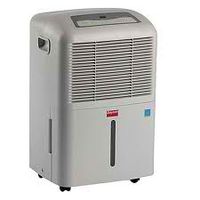Difference between revisions of "Dehumidificators"
PurplePen19 (talk | contribs) |
PurplePen19 (talk | contribs) |
||
| Line 9: | Line 9: | ||
A dehumidificator usually has a removable plastic bucket for a reservoir; most buckets also have a place where you can hook up a hose so the collected water can drain straight into a floor drain or pump. This frees you from having to remember to dump out the water. But don't worry too much about the reservoir overflowing -- most dehumidificator also have an automatic shut-off. If you're using a dehumidificator in extremely moist conditions, however, or if you need to keep your dehumidificator on all the time, you should look into a unit with a built-in condensate pump, which regularly pumps water out of the unit's reservoir rather than simply relying on gravity to empty it as a hose does. | A '''dehumidificator''' usually has a removable plastic bucket for a reservoir; most buckets also have a place where you can hook up a hose so the collected water can drain straight into a floor drain or pump. This frees you from having to remember to dump out the water. But don't worry too much about the reservoir overflowing -- most dehumidificator also have an automatic shut-off. If you're using a dehumidificator in extremely moist conditions, however, or if you need to keep your dehumidificator on all the time, you should look into a unit with a built-in condensate pump, which regularly pumps water out of the unit's reservoir rather than simply relying on gravity to empty it as a hose does. | ||
Many dehumidificator also have a humidistat, which allows you to set your desired level of relative humidity. A humidistat has two parts: a sensing element and a relay amplifier. The sensing element includes two alternate metal conductors, and changes in relative humidity will cause electrical resistance between those conductors. The relay amplifier measures this resistance and sends a signal to turn the dehumidificator on or off. These basic components add up to a device that may make your home feel a whole lot better. | Many dehumidificator also have a humidistat, which allows you to set your desired level of relative humidity. A humidistat has two parts: a sensing element and a relay amplifier. The sensing element includes two alternate metal conductors, and changes in relative humidity will cause electrical resistance between those conductors. The relay amplifier measures this resistance and sends a signal to turn the dehumidificator on or off. These basic components add up to a device that may make your home feel a whole lot better. | ||
Revision as of 20:43, 17 August 2012
A dehumidificator usually has a removable plastic bucket for a reservoir; most buckets also have a place where you can hook up a hose so the collected water can drain straight into a floor drain or pump. This frees you from having to remember to dump out the water. But don't worry too much about the reservoir overflowing -- most dehumidificator also have an automatic shut-off. If you're using a dehumidificator in extremely moist conditions, however, or if you need to keep your dehumidificator on all the time, you should look into a unit with a built-in condensate pump, which regularly pumps water out of the unit's reservoir rather than simply relying on gravity to empty it as a hose does. Many dehumidificator also have a humidistat, which allows you to set your desired level of relative humidity. A humidistat has two parts: a sensing element and a relay amplifier. The sensing element includes two alternate metal conductors, and changes in relative humidity will cause electrical resistance between those conductors. The relay amplifier measures this resistance and sends a signal to turn the dehumidificator on or off. These basic components add up to a device that may make your home feel a whole lot better.
